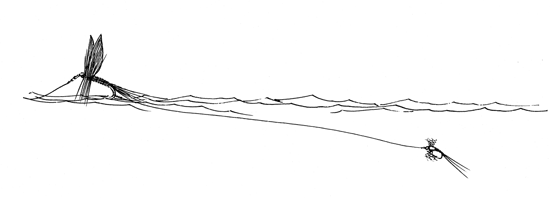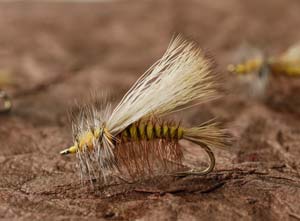Fishing Tandem Flies: Other Combinations

This heavy rainbow took a dark-colored conehead rabbit-strip fly trailed behind a white Zonker. When fishing tandem streamers, make sure that you fish different sizes, colors, or actions to cover more bases.
FISHING A DRY AND DROPPER is one possible combination. You can also fish two wet flies or two dry flies. You can even fish three (or more) wet flies or one dry and two wets, if the wets are small or if the dry fly is large and floats well. You are limited only by your fly selection and imagination.
Two Dry Flies
As I’ve grown older, I have more difficulty following a size 24 dry fly on the surface, especially if the flies float flush on the surface, such as spent spinners. Fishing two dry flies at once can help solve this problem. Tie an easy-to-see dry fly as your indicator fly and a size 24 Trico or other small pattern off the bend on 16 to 24 inches of tippet. Follow the indicator fly to help predict the smaller fly’s location.
Two dry flies aren’t just for older anglers. Many experienced midge fishermen use two flies — one larger and the other small — to help them track their miniscule patterns. Small dark terrestrials (or other patterns) are also hard to detect. If the trout are finicky, use a smaller dry, but even a size 18 indicator fly is easier to see than a drab little size 24. Use the first dry to help gauge the location of the second fly, and set the hook if there is a disturbance in the water near where you think your fly is or if the indicator fly hesitates or twitches.
Fishing two dry flies also helps you cover more bases if you don’t know what surface flies fish are feeding on. A few years back I was on the river during a fantastic Sulphur hatch in which flies emerged for more than a half hour and trout fed with frenzy. In addition to the duns, Sulphur spinners rode the surface, laying eggs before they died. Some trout fed barely underneath the surface on emerging duns while others ate floating, dying spinners. Because I couldn’t figure out exactly which phase fish were feeding on, I tied a spinner pattern to the bend of my dun. That evening I caught several trout on each fly, and the experience taught me a valuable lesson: If you’re not certain of the insect phase trout are taking, try several at the same time.
Sunken Dry Flies
After bobbing along on the water’s currents, many insects sink. The spent Trico spinners that have floated in fast water downriver for a mile eventually end up under the surface, where fish continue to feed on them. Sometimes the largest trout feed on the sunken insects. To catch difficult fish, I often fish a weighted spinner below a dry fly during and after a spinner fall, especially below riffles where the broken currents may have submerged spinners. Several species of mayflies also dive underneath the water to lay their eggs.

Don’t overlook the importance of sunken spinners. Fish a weighted spinner behind a dry fly during and after a spinner fall.
If I live to be a hundred, I’ll never forget the lesson an old angler taught me more than thirty years ago on Falling Springs Branch, near Chambersburg, Pennsylvania. I’ve written and talked about this incident many times, but it deserves to be restated. This old man kept catching one trout after another (at least seven fish) during a Trico spinner fall. I fished a hundred feet away and across stream from him, and in an hour I managed to land one small, wild fish. I cast my size 24 Trico over every riser in the area. When he caught his eighth trout, I had enough. I called out to him over the riffled water and asked him what fly he was using. He didn’t answer me, and I thought the old man was partially deaf, the stream’s din muffled my voice, or he was ignoring me. In about ten minutes the spinner fall ended, and the old man wound up his line and headed for his car.
As he turned and walked away, he muttered four words that still haunt me today: “I’m sinking the fly.” He never once looked at me.
I pondered the man’s words on my two-hour trip home that afternoon. Then it came to me in an instant: That old codger was fishing his Trico spinner pattern under the surface as a wet fly. It made a lot of sense. Some of the spinners sank. Why not tie some patterns to copy them? I tied a half-dozen spent-wing wet flies, adding five wraps of lead wire to the hook shanks, and looked forward to using them soon.

Tricos are so small that you can design a sinking fly by tying it on a heavy-wire hook and keeping the profile streamlined.
But soon didn’t happen for more than a decade. In early August 2002, 2,000 miles away from Falling Springs Branch, Jerry Armstrong and I were committed to teach a one-week fly-fishing program on the Ruby River at Upper River Outfitters near Alder, Montana. I arrived at the lodge one day before the workshop to get the lay of the land and to fish the river. I arrived on the Ruby around 8:30 A.M. and diminutive, clear-wing Trico spinners already filled the cool morning air. Wind gusts blew them into my mouth. When the females started landing on the surface, the trout began to rise. I began casting and casting, but nothing I used worked.
Within minutes after I started fishing, several registrants for next day’s class wandered down to watch their instructor. The pressure was on. Tomorrow, I planned a talk based on my book How To Catch More Trout. I fished for 5 minutes, 10 minutes, 15 minutes — and couldn’t catch a trout. My students could probably sense my discouragement. Would they listen to anything I said in the upcoming program if I couldn’t catch any of these trout? I glanced over at the group across the river, and I saw them whispering to each other. What would I do? How could I teach the class tomorrow to people who clearly saw I couldn’t catch one trout, let alone more trout?
Then, I had an idea. Since there were only a few trout rising during this dense spinner fall, I thought about trying one of the sunken spinners I had tied up years ago. I dug through my box of Tricos and found the weighted patterns — still intact — that I had tied fifteen years ago. I quickly tied one on 24 inches of tippet to the bend of a size 16 Patriot and began casting. On the second cast, the Patriot sank, and I set the hook on a 12-inch rainbow. Two more casts, and I caught another trout on the spinner. By the sixth trout, the group across the river began applauding. I was safe for tomorrow.
Another way to catch fish during the summer doldrums is to fish sunken terrestrials. Terrestrials fall into the water all the time, and those that don’t swim to shore often end up under the water. I have fished weighted ant and beetle patterns for years. I add a copper bead as the front hump of a cinnamon ant pattern to sink it quickly. Many anglers overlook sunken grasshopper and cricket imitations, but trout don’t.
Wet Flies
You can fish two or more wet flies under a large dry fly, under an indicator, or without an indicator — especially if you are swinging flies, like the older method of fishing a cast of wet flies downstream. The most popular connections for nymphs are bend connections, two eye, or droppers, but you can also connect looped-leader nymphs to dropper loops or to knotted leaders (placed just above a knot).
There are several effective configurations for fishing nymphs, depending on the circumstances. You can first tie on a heavily weighted pattern to sink the rig, followed by a pattern that floats freely in the currents. I’ll often fish a weighted Beadhead Pheasant Tail with a Zebra Midge tied to the bend. The weighted fly gets the rig deep and the unweighted midge pattern drifts freely above the heavy fly. Many anglers have one or two specialty flies that they like to use for this purpose. The best patterns are generic enough so that you can use them throughout the season, and sink quickly — the Copper John is an excellent example of a generic pattern that can also be used as a weighted first fly. The second option is to first tie on the smaller pattern followed by the larger, weighted one.

When fishing heavily weighted flies for fast currents, strike indicators are often a better choice than indicator flies. You can rig your flies in many different ways. The dropper (left) and bend connections (right) may be the most popular.
The setup you choose may depend on what you have already tied on. For instance, if you are fishing a heavy nymph but want to cover another area in the water column with an emerger, you may just attach the emerger above the tippet knot with a movable dropper, or retie the fly, leaving a tag large enough to attach the emerger. If you don’t feel like rerigging, you can attach the emerger to the bend of the heavy nymph. There are always several available options with these combinations, and you should experiment and let the trout tell you which one they like best.
In the Czech-nymphing style of fishing, anglers fish heavily weighted, streamlined nymphs (so that they sink quickly), most often three at a time. They connect two nymphs on droppers and one on point and most often tie the heaviest fly pattern on the middle dropper, so that the weighted fly helps sink both the first dropper and the point fly.
Fishing several subsurface patterns is often a better choice in high water than fishing a dry-and-dropper rig. Though the dry-and-dropper rig is versatile, it is best for water depths from one to four feet and slower to medium currents. In high, fast water, fish one or more weighted nymphs under a supersized indicator fly or indicator. The downside of using a fly large enough to float these weighted flies — like some of the foam hopper and stoneflies popular in the West — is that they can be less aerodynamic to cast than some strike indicators — though large polypropylene yarn indicators are no joy to cast. Fast-action rods and line weights and leader tapers designed for turning over heavier, wind-resistant flies make casting large foam hoppers, stoneflies, and Chernobyl Ant-style patterns relatively painless.

Two popular ways of connecting tandem streamers are the bend (top) and two-eye connections (bottom). Some anglers think that the streamers have more action with the two-eye connection, though I find it easier to tie tippet on to the bend of a hook than through a hook eye already crowded with tippet.
Streamers
Fishing two streamers is a deadly way to entice the largest fish to strike. The two most popular connections for fishing tandem streamers are the bend and two-eye connections. When fishing streamers, choose flies with different colors and sizes. Fish one fly that is smaller than the other, and fish flies that are both light and dark to cover as many bases as possible. Woolly Buggers are always good choices to imitate large hellgrammites, stonefly nymphs, as well as crayfish and sculpins, and you can’t go wrong with rabbit-strip flies such as Zonkers or Double Bunnies. You don’t cast two streamers as much as you lob them. It isn’t pretty, but the combination is deadly. Two of my favorite Woolly Bugger variations are the Beadhead Woolly Bugger and Rooke’s Minnow.
The easiest setup for fishing multiple streamers from a drift boat is a short sinking-tip line with a floating running line and a short, straight piece of tippet heavy enough to help turn over the flies, prevent break offs when fish slam your fly, and stout enough to pull your flies from snags or the occasional bush as you pound the banks. Fish typically aren’t leader shy with streamers because they often see the fly first and the fly is generally fished on an active retrieve.
In addition to an active retrieve, a combination of dead-drifting and short strips also works well. Many anglers fish tandem streamers with a floating line and tapered leader. Good casting technique is essential with this setup, as is the leader’s taper design. Use weight-forward lines with heavy front tapers (nymph and bass tapers) and leaders with large butt diameters that extend through at least half of the entire leader’s length. It helps to build your own, but Umpqua sells a leader they call the weight-forward leader that turns over tandem streamers well. When fishing double streamers, it’s imperative to modify your casting stroke, not only to prevent tangles, but to prevent hitting yourself with the heavy flies.
Though many anglers don’t use them, streamer and nymph combinations also work well, perhaps because the larger streamer draws the fish’s attention to the nymph. On central Oregon’s Deschutes River I had a great five-mile float casting a Woolly Bugger and Pteronarcys stonefly imitation in tandem. Thousands of huge stonefly nymphs crawled out of the water, and we caught lots of fish dead-drifting and twitching this rig as we floated downriver.













